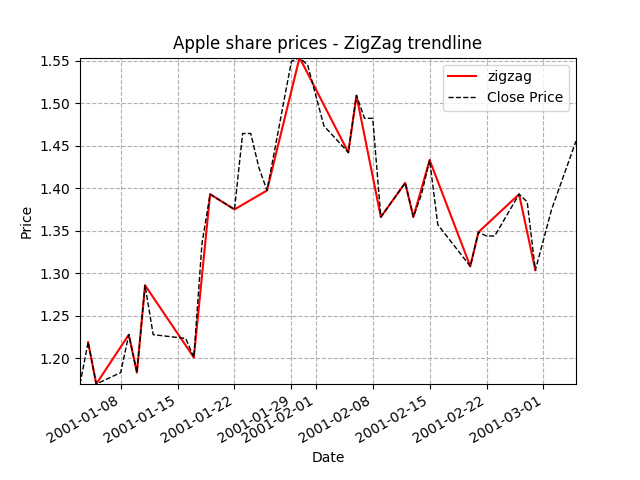In Python, to draw a zigzag trendline of stock prices, you need to first find the peak and valley values of the chart. This can be done by using scipy.signal.argrelextrema() function. Then, you have to combine them together and sort them in chronological order. After this, you end up forming a zigzag trendline. The code below show you how to draw a zigzag trendline of Apple stock prices. It is assumed that you have the following libraries installed on your computer:
- numpy:
pip install numpy - matplotlib:
pip install matplotlib - pandas:
pip install pandas - scipy:
pip install scipy
The code
#!/usr/bin/python3 import matplotlib matplotlib.use('Agg') # Bypass the need to install Tkinter GUI framework # Avoid FutureWarning: Pandas will require you to explicitly register matplotlib converters. from pandas.plotting import register_matplotlib_converters register_matplotlib_converters() from scipy import signal import numpy as np import matplotlib.pyplot as plt import matplotlib.dates as mdates import pandas as pd # Load data from CSV file. ########################## my_headers = ['date', 'open', 'high', 'low', 'close', 'volume'] my_dtypes = {'date': 'str', 'open': 'float', 'high': 'float', 'low': 'float', 'close': 'float', 'volume': 'int'} my_parse_dates = ['date'] loaded_data = pd.read_csv('apple.csv', sep='\t', header=1, names=my_headers, dtype=my_dtypes, parse_dates=my_parse_dates) # Convert 'Timestamp' to 'float'. # Need time be in float days format - see date2num. loaded_data['date'] = [mdates.date2num(d) for d in loaded_data['date']] # Re-arrange so that each line contains values of a day: 'date','open','high','low','close'. quotes = [tuple(x) for x in loaded_data[['date','open','high','low','close']].values] # Create zigzag trendline. ######################################## # Find peaks(max). data_x = loaded_data['date'].values data_y = loaded_data['close'].values peak_indexes = signal.argrelextrema(data_y, np.greater) peak_indexes = peak_indexes[0] # Find valleys(min). valley_indexes = signal.argrelextrema(data_y, np.less) valley_indexes = valley_indexes[0] # Instantiate axes. (fig, ax) = plt.subplots() # Merge peaks and valleys data points using pandas. df_peaks = pd.DataFrame({'date': data_x[peak_indexes], 'zigzag_y': data_y[peak_indexes]}) df_valleys = pd.DataFrame({'date': data_x[valley_indexes], 'zigzag_y': data_y[valley_indexes]}) df_peaks_valleys = pd.concat([df_peaks, df_valleys], axis=0, ignore_index=True, sort=True) # Sort peak and valley datapoints by date. df_peaks_valleys = df_peaks_valleys.sort_values(by=['date']) # Plot zigzag trendline. ax.plot(df_peaks_valleys['date'].values, df_peaks_valleys['zigzag_y'].values, color='red', label="zigzag") # Plot close price line. ax.plot(data_x, data_y, linestyle='dashed', color='black', label="Close Price", linewidth=1) # Customize graph. ########################## plt.xlabel('Date') plt.ylabel('Price') plt.title('Apple share prices - ZigZag trendline') # Format time. ax.xaxis_date() ax.xaxis.set_major_formatter(mdates.DateFormatter("%Y-%m-%d")) plt.gcf().autofmt_xdate() # Beautify the x-labels plt.autoscale(tight=True) plt.legend(loc='best') plt.grid(True, linestyle='dashed') # Save graph to file. plt.savefig('argrelextrema-zigzag.png')
Output

apple.csv sample data
date open high low close volume 2001-01-02 1.062500 1.089286 1.040179 1.062500 113078000 2001-01-03 1.035714 1.191964 1.031250 1.169643 204268400 2001-01-04 1.295757 1.321429 1.200893 1.218750 184849000 2001-01-05 1.209821 1.241071 1.147321 1.169643 103089000 2001-01-08 1.209821 1.213164 1.138393 1.183036 93424800

